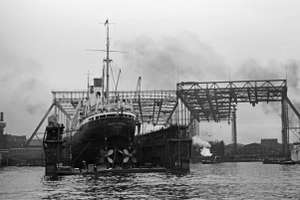MV Monte Pascoal (1930)
Monte Pascoal was a Monte-class ocean liner built in 1930 by Blohm & Voss, Hamburg for the Hamburg-Südamerikanische Dampfschifffahrts-Gesellschaft. She managed to reach Germany after the outbreak of World War II and was requisitioned by the Kriegsmarine for use as an accommodation ship. She was sunk in 1944 during an Allied air raid on Wilhelmshaven. Subsequently refloated, she was seized by the Allies post war and was scuttled in the Skaggerak with a cargo of gas bombs in 1946.
 Monte Pascoal, before her launch | |
| History | |
|---|---|
| Name: | Monte Pascoal |
| Namesake: | Monte Pascoal |
| Owner: |
|
| Port of registry: |
|
| Builder: | Blohm & Voss |
| Yard number: | 491 |
| Launched: | 17 September 1930 |
| Completed: | 15 January 1931 |
| Maiden voyage: | 26 January 1931 |
| Out of service: | 3 February 1944 |
| Identification: |
|
| Fate: | Scuttled, 31 December 1946 |
| General characteristics | |
| Class and type: | Monte-class ocean liner |
| Type: |
|
| Tonnage: | 13,870 GRT, 7,762 NRT |
| Length: | 152.60 metres (500 ft 8 in) |
| Beam: | 19.99 metres (65 ft 7 in) |
| Depth: | 11.48 metres (37 ft 8 in) |
| Decks: | Four |
| Installed power: | 4 diesel engines, 1,436 nhp |
| Propulsion: | Twin screw propellers |
| Speed: | 14 knots (26 km/h) |
| Capacity: | 2,500 passengers |
| Notes: | Sister ships Monte Cervantes, Monte Olivia, Monte Rosa and Monte Sarmiento, |
She can be briefly seen moored in London's docks in the short 1939 travelogue film "River Thames".
Description
Monte Pascoal was 152.60 metres (500 ft 8 in) long, with a beam of 19.99 metres (65 ft 7 in). She had a depth of 10.87 metres (35 ft 8 in). The ship was assessed at 13,870 GRT, 7,762 NRT. She was powered by four four stroke single cycle, single action diesel engines which drove twin screw propellers through single reduction gearing. The engines were rated at 1,436 nhp. They were built by Blohm & Voss, Hamburg.[1] The engines could propel the ship at 14 knots (26 km/h). Accommodation for 2,500 third class passengers was provided. This was reduced to 1,500 when the ship was used for cruises.[2]
History
Monte Pascoal was built as yard number 491 by Blohm & Voss for the Hamburg-Südamerikanische Dampfschifffahrts-Gesellschaft. She was launched on 17 September 1930 and was completed on 15 January 1931. She made her maiden voyage on 26 January, sailing from Hamburg to ports on the Río de la Plata, South America. Apart from use on the South American route, she also operated cruises off the coast of Norway and in the Mediterranean Sea.[3] Her port of registry was Hamburg.[1] In August 1933, she operated a series of cruises between Hamburg and Greenwich.[4]

In 1934, the Code Letters DIDT were allocated.[1] During the Spanish Civil War, Monte Pascoal repatriated 226 German volunteers from Sevilla back to Hamburg in June 1937.[5] In January 1939, a Heinkel He 115 aircraft, registration D-AEHF, suffered an engine failure over the Atlantic Ocean. The aircraft landed alongside Monte Pascoal, which rescued the crew and lifted the aircraft from the water using a derrick at the bow of the ship.[6]
When war broke out in September 1939, Monte Pascoal was in Buenos Aires, Argentina. Departing on 10 September without passengers and two of her crew having refused to sail,[7] she made a successful run back to Germany, arriving at Hamburg on 14 October 1939. On 11 January 1941, Monte Pascoal was requisitioned by the Kriegsmarine. She was used as an accommodation ship at Wilhelmshaven.[3] On 3 February 1944, the United States Eighth Air Force bombed Wilhelmshaven.[8] Monte Pascoal was set afire and was scuttled. She was refloated on 12 May and beached. In May 1945, she was seized as a prize of war by the United Kingdom. On 5 August 1946 she departed from Wilhelmshaven for Hamburg. Monte Pascoal was scuttled in the Skaggerak on 31 December 1946 with a cargo of obsolete gas bombs on board.[3]
References
- Lloyd's of London (1935). "Lloyd's Register, Navires a Vapeur et a Moteurs" (PDF). Plimsoll ship data. Retrieved 1 August 2015.
- "Hamburg Sued". Trains worldexpress. Retrieved 1 August 2015.
- Borek, Sebastian. "Accommodation ship MONTE PASCOAL in the port of Wilhelmshaven, September 1943". Aanimeri. Retrieved 1 August 2015.
- "From Greenwich to Hamburg". The Times (46514). London. 4 August 1933. col A, p. 12.
- "226 Germans leaving Spain". The Times (47703). London. 5 June 1937. col D, p. 13.
- "MONTE PASCOAL (1930 - 1945)" (in German). Schiffe-maxim. Retrieved 1 August 2015.
- "Argentine sympathy with Allies". The Times (48407). London. 11 September 1939. col F, p. 7.
- Rohwer, Jürgen; Gerhard Hümmelchen. "Seekrieg 1943, Februar". Württembergische Landesbibliothek Stuttgart (in German). Retrieved 1 August 2015.